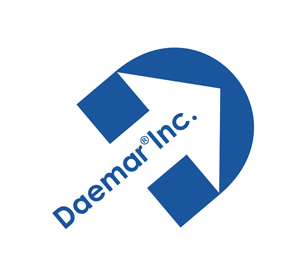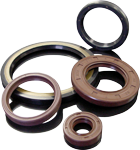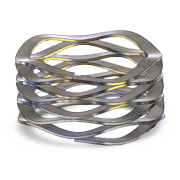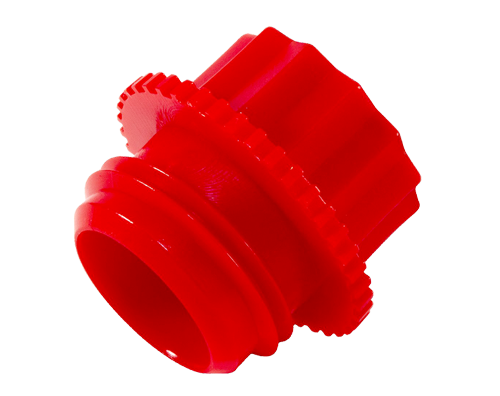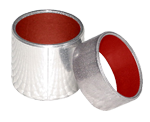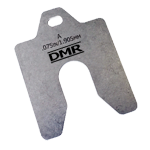Home >> Slide >> Dryslide Bushings >> Bushing Design Notes
Design Notes
CHEMICAL PROPERTIES
The PTFE sliding layer is resistant to most chemical products, while the corrosion resistance of TH bushing depends on the steel backing which does not oxidize when:
- Immersed in water, alcohols or glycols;
- In the presence of minerals and synthetic oils;
- In acid substance with a pH level of > 5;
- In alkali substance with a pH level < 9.
Corrosion is triggered off in the case of repeated wet/dry cycles, the presence of oxygen and when the temperature exceeds 90°C.
The chemical resistance of TH bushing is improved by tin-plating, but the problems of corrosion must be overcome by further protection such as special tin-plating, by sealing the bearings or by using the bronze-backed bearings (TH-B) or stainless steel backed bearings (TH30).
THERMAL CONDUCTIVITY
During operation heat is generated by the friction between the bearing and the shaft. The heat is partly dissipated by the fluids present (gas or liquids) and the partly absorbed by the mating parts. Under normal operating conditions, the bearing must be able to dissipate the heat generated and not give rise to thermal dilations that may compromise the working of the two parts. Under both aspects, TH bushing performs very well as it features:
Perpendicular thermal conductivity which is linked to the steel backing and the close contact of the bronze and the polymer layer. Both factors lead to high level of thermal conductivity between the layers that enables the heat to be eliminated without causing a sharp rise in the temperature (on average + 20° to 25° C compared to the temperature environment).
Volumetric expansion: the increase in temperature gives rise to an expansion in the volume of materials. Given the composition of the product, TH bushings expands in a way very similar to that of metals normally used for the housing and the counterpart. This similar behavior prevents seizure during heating and movement of the bearing in the housing during cooling which sometimes arises when plastic bearings are used.
ELECTRICAL CONDUCTIVITY
TH bushing not only offers a high level of thermal conductivity, but also a high level of electrical conductivity that is perpendicular to the layers. However, this electrical conductivity only appears after the first running-in period, when the bronze starts to be exposed and comes into contact with the mating surface. The perpendicular electrical conductivity increases with the specific load applied on the bearing and with the degree of wear. Typical values of specific electrical resistance for units-surface are the following:
Perpendicular electrical resistance: R= 1-10Wx cm²
FRICTION
The TH bushing sliding layer has a PTFE base that gives an excellent slide equality due to low coefficient of friction. The amount of friction cannot be defined exactly as it is influenced by the following parameters:
- Load factor p x v on the surface
- Operating temperature
- Presence of liquids and lubricants
- Material and finish of the mating surface
The load factor p x v is the result of the specific load p (N/mm(2)) and the speed v (m/s) and represents the reference parameter for checking the performance of this type of bearing. p x v being equal, the coefficient of friction decreases as the specific load increases, while the coefficient of friction increases as the speed increases.
| Sliding Speed v (m/s) | Specific Load p (N/mm(2)) | Coefficient of Friction µ |
|---|---|---|
| Up to 0.001 | 140 | 0.03 |
| 0.001 to 0.005 | 140 to 62 | 0.04 to 0.07 |
| 0.005 to 0.05 | 62 to 11 | 0.7 to 0.1 |
| 0.05 to 0.5 | 11 to 1 | 0.1 to 0.15 |
| 0.5 to 2 | 1 | 0.15 to 0.20 |
TEMPERATURE
The temperature has a very slight effect on the coefficient of friction if it remains within range of 0° to 100°. once these limits are exceeded, the coefficient of friction increases rapidly by 50% or more. It should be noted that very high temperatures reduce the useful life of TH bearings. Under equal load factors, the useful life is reduced by 80% at a temperature of over 200°C compared to that noted at 25°C.
LIQUIDS AND LUBRICANTS
TH bearings have been designed for dry operations, but despite this, the presence of clean fluids in the working area can facilitate the dissipation of heat and prolong the useful life of the bearing. The presence of liquids, whether lubricants or other , may lead to hydrodynamic operating conditions which enable a considerable increase in the sliding speed at the same specific load. Hydrodynamic operating conditions are influenced by the following parameters:
- Sliding speed
- Specific load
- Tolerance of the mating surfaces
- Viscosity of the liquid
- Operating temperature
OPERATION IN THE PRESENCE OF LIQUIDS AND LUBRICANTS
In practise, even the self-lubricated bearings (TH Series) can be used in the presence of liquids and/or lubricating fluids.
In these situations, the behavior of the bearings are modified and the following considerations apply:
- The presence of a clean fluid on the bearing (whether lubricating or not) usually has a positive effect as it improves the dissipation of the heat caused by the friction and also improves the contact between the sliding surfaces.
- It is necessary to check the compatibility of the bearing with the fluid. Most problems arise with the THX bearings as the acetal co-polymer is not recommended for use in water, glycols or synthetic oils with phosphoric esters. The other TH Series does not have any particular contradictions in the presence of widely used liquids and lubricants. If in doubt and in case of special applications, it is advisable to carry out a simple test by immersing half of a sample bearing in the liquid in question. If, after two weeks, the bearing shows no sign of alteration in any part it can be considered to be compatible with the fluid.
- For the TH Series of bearings, the positive effects of the presence of fluids are confirmed only if altering dry and wet cycles are avoided. In the presence of repeated cycles, the result is a premature decline in the product compared to dry operating conditions.
- For the bearings subject to lubrication, just the initial greasing may be sufficient as long as the application is subject to limited specified load and speed values.
